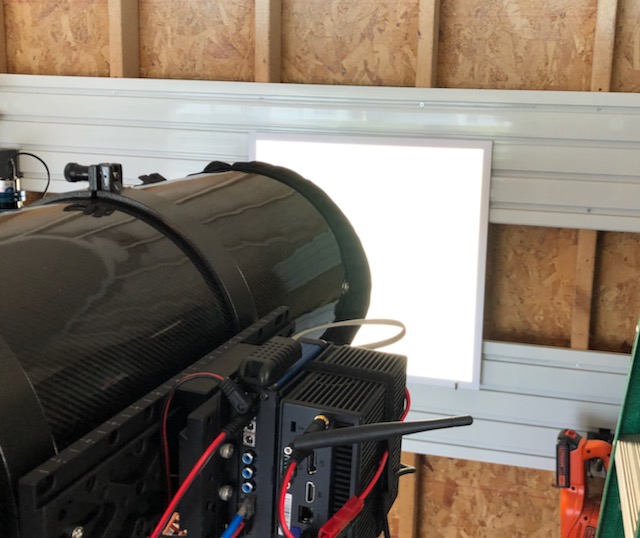A few years ago on a hunch, I bought a 24x24" network connected led light from Unifi. It was quite a bit cheaper than other large astro panels out there. I tested it to check for uniformity and it all looked good enough for me. I ended up selling the AT10RCT that I was planning to use with it and didn’t have an immediate use for it. Now I have my ONTC1010 f/4 scope mounted in the garage ready to go for imaging, so decided to set this up. I gave a comprehensive writeup of this panel here when I first got it.
The panel has an app that lets you turn it on/off and control the brightness. Unfortunately, it can only go down to 10% brightness, which I found is too bright for some filters. I looked at the packets sent between the phone and panel to find out it’s using the mqtt protocol. I wrote a simple api that will interface with the panel using mqtt, but you interact with it using a webpage or GET requests from the command line. The great thing is with the mqtt protocol, the brightness can be set down to 1%, which is great for the faster newtonian. Here’s the source code for that in case anyone wants to use it
Last night with this setup, I was able to quickly get flat frames for my ONTC1010 with Voyager. This should also work with my smaller refractors that are too small for the flip flat I have. My plan is to add a script that Voyager will use to automatically turn on/off and set the brightness levels as needed before running the flat sequences.
Gabe
4 Likes
Thank you so much Gabe, really nice addition.
All the best
Leonardo
I was talking to @Diego_Colonnello about either a generic telnet2serial driver for Voyager or a specific TCP/IP connected flat panel protocol and hardware that we coudl use to start to eliminate the annoying mess of USB cables around the OTA, this is a great example of how it can be done.
Really nice Gabe,
Lately, I’ve been playing with Home Assistant (open source automation hub), I am trying to hook it to Voyager/Viking. Home Assistant will connect to MQTT broker and expose the connected devices by different endpoint including a REST API.
Cheers,
José
Thanks guys. I agree Paul that a networked protocol would be nice to move towards. I currently have that panel networked via a wireless bridge, so all it needs is a POE injector, no usb or ethernet. That simplifies installation.
Jose, I was first introduced to MQTT from using HA! HA is a great project that I use in tandem with other home automation tech around our house. Just imagine using google home or alexa to tell your telescope system to start running its dragscript for the night 
3 Likes
@gabe - are you thinking a generic RFC 2217 serial-to-telnet (ser2net) style approach or something more device specific?
I am slightly nervous about suggesting improvements, so in the meantime I’ll continue to use the HW Group’s HW Virtual Serial Port RFC2217 driver. It appears to Windows/Voyager like a COM port but provides a telnet link back to a ser2net server running on the Raspberry Pis connected to the devices.
Works fine for both my Flat Panel (and my Nexdome) - all connected via Ethernet - no more long serial cables hanging off the mount, yay!

